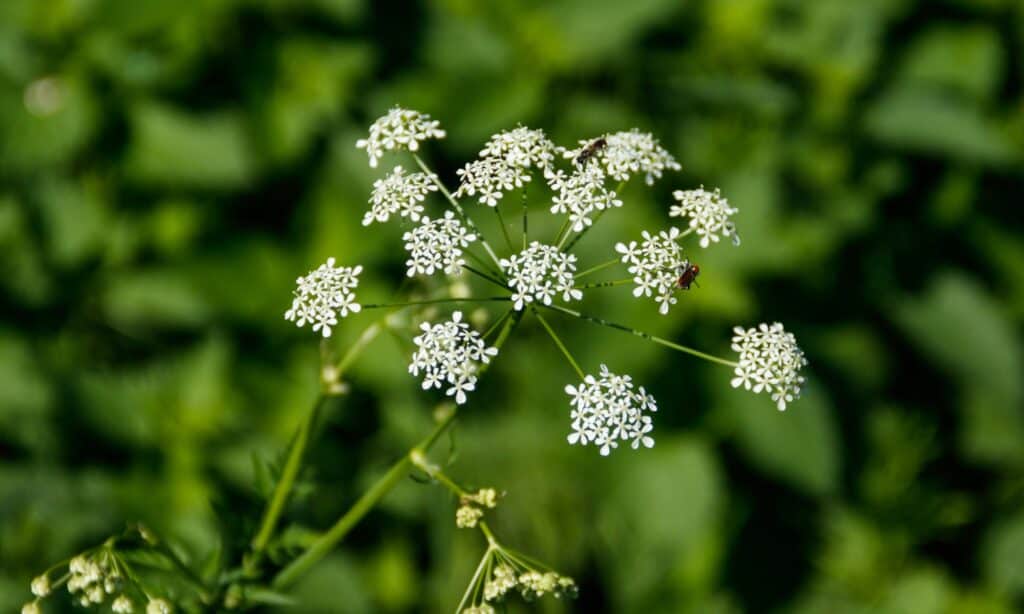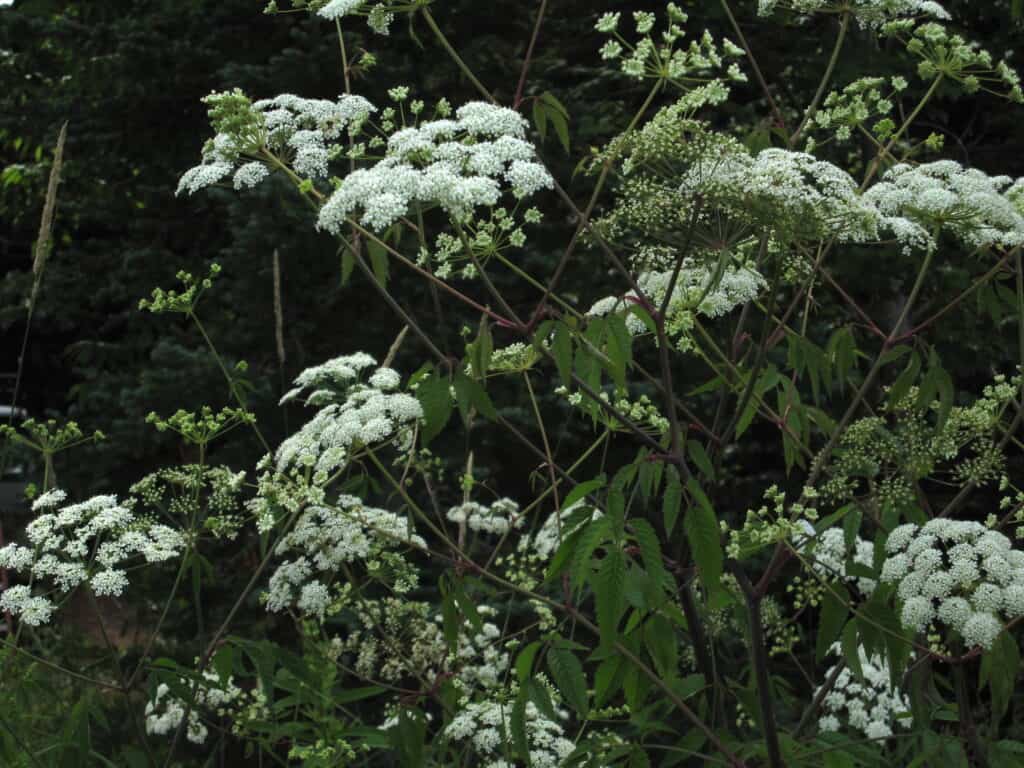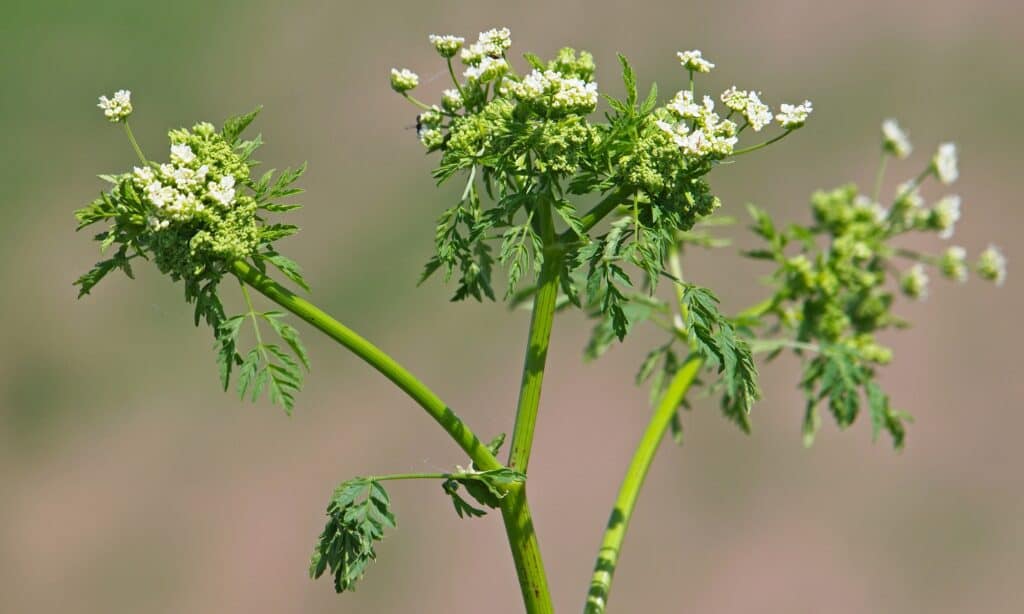In the summer of 2022, visitors to a park in Dallas, Texas, were warned: growing around a local lakefront was a plant described by the U.S. Department of Agriculture (USDA) as “the most violently toxic plant that grows in North America.” That USDA description applies to a plant identified as invasive water hemlock. It was growing around White Rock Lake, a water reservoir five miles northeast of downtown Dallas.
Park visitors at White Rock Lake were made aware of the danger. In fact, officials from the Dallas Department of Parks and Recreation called removing the plant called “an urgent priority.” Because pulling or moving the hemlock was deemed too risky, park officials decided to treat the plant with herbicide. The entire event was enough to make the news. But what is invasive water hemlock anyway, and why did it raise such an alarm?
Read on to learn more about this species of invasive water hemlock. Why it is dangerous? And most importantly, how can you learn to identify it for yourself?
What is Water Hemlock?
Water hemlock, which has the scientific name of Cicuta maculata, is a species of plant in the Apiaceae family. Apiaceae is also known as the “celery family,” “carrot family,” and “parsley family,” or, collectively, “umbellifers.” The Cicuta genus includes four species of poisonous plants: Cicuta bulbifera, Cicuta douglasii, Cicuta maculata, and Cicuta virosa. Of these four, the most common in North America is Cicuta maculata.
Cicuta maculata is a species that goes by multiple colloquial names. It’s commonly known as “spotted parsley,” “spotted cowbane,” or even “suicide root,” a name denoting its toxic properties. Cicuta maculata is one of two species of water hemlock recognized by taxonomists as growing across the North American continent. The second, Cicuta douglasii, “western water hemlock,” is contained to the northwestern part of the United States and parts of western Canada.
The plant found growing in Texas was Cicuta maculata. Water hemlock is considered a wetland plant, as it grows in wet soil like that typically found in marshes or bogs, surrounding ponds, in damp meadows, and on the banks of streams or nearby ditches. Or growing beside a lake in Texas! Because its appearance is similar to that of other members of the Apiaceae family, such as wild carrots or parsnips, it is commonly confused with these non-toxic plants. This can lead some to mistakenly consuming parts of the water hemlock plant. However, that mistake can prove deadly because water hemlock is extremely toxic to humans.

Water hemlock is a wetland plant that is extremely toxic to humans.
©iStock.com/OlyaSolodenko
Toxicity
Water hemlock is full of two toxic chemical compounds: cicutoxin and cicutol. The two are naturally occurring unsaturated alcohols. Cicutoxin and cicutol are in all parts of the water hemlock plant but are especially potent in the roots. Ingesting any part of the water hemlock’s naturally occurring toxin will disrupt the central nervous system and can prove lethal for both humans and animals like cattle, horses, and sheep.
Multiple deaths have been documented of people who mistakenly ate water hemlock believing it to be its relative, an edible wild carrot, or who accidentally ingested part of the plant. It is also a relative of the hemlock plant that created the poison that famously killed Socrates. When eaten, it will cause vomiting, tremors, and seizures, and can result in death in as few as 15 minutes, with symptoms typically appearing only 30 to 60 minutes after ingestion. As a result, water hemlock is known as one of the most toxic plants in North America.
Appearance
Water hemlock is a perennial plant that blooms with five-petaled white flowers that are each about 1/8 inch across and have notched tips. Each summer, the flowers bloom in the middle of the summer for about a month with a slight fragrance. They grow in umbrella-shaped clusters that look similar to Queen Anne’s Lace (wild carrot, or Daucus carota), and which then produce two seeds to be dispersed by wind and water. The plant’s leaves are long and alternating and the plant’s stems are smooth and hollow, with long branches growing green, purple, or green with purple streaks. It typically grows 3 to 6 feet tall and can branch, with stems that have prominent veins along the length of the stem.
Though Cicuta maculata has a similar appearance to many other species in the Apiaceae family, water hemlock is also commonly mistaken for elderberry (Sambucus nigra), which has flowers that look similar and often grows in wetlands. However, elderberry fruits and flowers may be eaten and water hemlock certainly should not be. Water hemlock can be identified by double compound leaves and large leaflets that do not typically have lobes. This is in comparison to other members of Apiaceae, which have simple compound leaves, smaller leaflets, or deeply-lobed leaflets. Another distinctive characteristic is forking veins that end at the notches along the leaf margins, and not at the tip of the leaf margins like other members of Apiaceae.

Water hemlock grows in umbrella-shaped clusters and is known as one of the most toxic plants in North America.
©Williammehlhorn at English Wikipedia, Public domain, via Wikimedia Commons – License
Water Hemlock vs. Poison Hemlock
Water hemlock is often confused with Conium maculatum, or “poison hemlock.” The two have similar names and a shared toxic quality. Both are members of the Apiaceae family, are considered poisonous plants, and grow in wetlands throughout North America. They also bloom in a similar time period, during the summer months between June and August. They also grow similar flowers that appear in umbrella-like groupings.
However, water hemlock is more deadly than poison hemlock. While both have spotted or blotchy stems, the leaflets are less finely divided than those of poison hemlock. While poison hemlock is a biennial, or sometimes a short-term perennial, water hemlock is a perennial.

Poison hemlock is a biennial plant that has a similar appearance and toxicity, but water hemlock is more deadly.
©iStock.com/emilio100
Plant Control
Because it is a perennial, water hemlock grows and reproduces from its root system. With this in mind, systematic herbicides can address an invasive water hemlock problem. The herbicide will kill the entire plant from the root. Since water hemlock is typically found growing in wetlands near water, it is important to use an aquatic herbicide that contains glyphosate and imazapyr. To reduce the plant’s spread, it is best to eliminate the plant while it is in early bloom, in the spring to early summer. This will allow the plants to be removed entirely from the moist soil before the plants are able to produce mature seeds.
Even touching water hemlock can irritate the skin, so you should wear gloves and other protective gear when handling any part of the plant.
What to Do if You Encounter Water Hemlock
If you encounter water hemlock in a park or on your property, there is no need panic. It is beautiful. You might even think it is an attractive addition to the landscape. However, it is very dangerous and can be deadly for people and animals. Therefore, look out for plants that you suspect might be Cicuta maculata while on a stroll at your local park. Then, alert your local Department of Parks and Recreation so that they can take the necessary steps to remove it from the park and protect visitors and animals. If you find it on your property, consult with local experts and safely remove it while following safety precautions. This plant is beautiful, but it is also deadly.
If you somehow ingest water hemlock by accident, it is important to seek medical care immediately. Although the ingestion of water hemlock can lead to serious health effects and physical complications that may be fatal, the long-term prognosis is good if the affected person accesses medical care quickly.
Up Next
- Poison Hemlock vs. Wild Carrot: 5 Key Differences
- Discover the Most Dangerous Plants in the United States
- Swamps and Wetland
The photo featured at the top of this post is © Jerrold James Griffith/Shutterstock.com
Sources
- USDA/Walter Fertig, Available here: https://www.fs.usda.gov/wildflowers/plant-of-the-week/cicuta_maculata.shtml
- Clinical Neurotoxicology, Available here: https://www.sciencedirect.com/topics/agricultural-and-biological-sciences/cicuta
- National Library of Medicine, Leo J Schep 1, Robin J Slaughter, Gordon Becket, D Michael G Beasley, Available here: https://pubmed.ncbi.nlm.nih.gov/19514873/
- Iowa State University, Available here: https://crops.extension.iastate.edu/encyclopedia/poison-hemlock#:~:text=Poison%20hemlock%20is%20a%20much,finely%20divided%20like%20poison%20hemlock.
- Slate/Big, Bad Botany: Hemlock (Conium maculatum), the Philosopher’s Choice/Michael Largo, Available here: https://slate.com/technology/2014/08/poisonous-plants-socrates-drank-hemlock-tea-as-his-preferred-mode-of-execution.html
- University of Florida Center for Aquatic and Invasive Plants, Available here: https://plants.ifas.ufl.edu/plant-directory/cicuta-maculata/
- Oregon State Extension, Available here: https://extension.oregonstate.edu/crop-production/pastures-forages/poison-hemlock-western-waterhemlock-deadly-plants-may-be-growing
- North Carolina Extension, Available here: https://plants.ces.ncsu.edu/plants/cicuta-maculata/
- (1970)
Thank you for reading! Have some feedback for us? Contact the AZ Animals editorial team.






